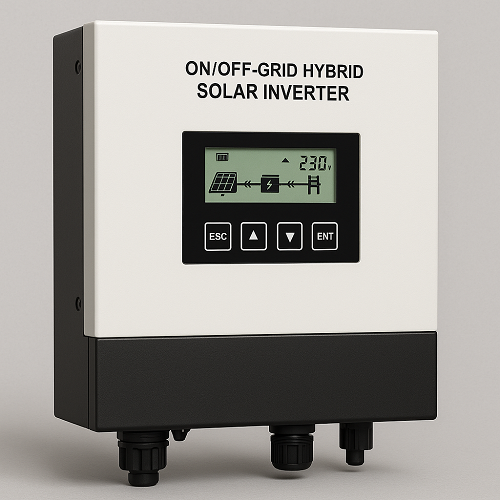The rapid development of renewable energy solutions has driven significant advancements in solar technology. Among these innovations, the on off grid hybrid solar inverter stands out for its versatile and efficient system, bridging the gap between traditional grid-connected and fully off-grid solar installations. This hybrid solution not only enhances energy independence but also maximizes solar energy utilization while offering flexibility and reliability.
An on off grid hybrid solar inverter is a versatile device that combines the advantages of grid-connected and off-grid solar systems. It allows users to harness solar energy to power their homes or businesses, store excess electricity in batteries for later use, and seamlessly switch between the grid, batteries, and solar power based on power supply conditions and demand.
Unlike traditional inverters that are either grid-connected or battery-dependent, hybrid solar inverters are designed with solar energy as the priority, storing excess electricity in batteries and drawing power from the grid when necessary. This makes it a self-sufficient power solution, particularly suitable for areas with frequent power outages or unstable grid supply.
Key features of the on off grid hybrid solar inverter
- Dual functionality (grid-tied + off-grid): The hybrid inverter can feed excess solar energy into the grid (if permitted by the local utility company), helping users earn credits through net metering. It can also operate independently of the grid, drawing power from its battery bank during outages or at night.
- Battery integration: Unlike traditional grid-tied inverters, hybrid inverters are designed to work with battery storage systems. This enables households or businesses to store excess solar energy and use it during peak hours or when solar generation is low.
- Smart energy management: Many modern hybrid inverters are equipped with advanced monitoring systems. These systems allow users to track energy production, battery status, and consumption in real-time via a mobile app or web-based control panel.
- Automatic Switching: The inverter intelligently selects the power source—solar, battery, or grid—based on supply conditions and demand to ensure an uninterrupted power supply.
- Load Priority Settings: Users can configure priority loads that must remain powered at all times, such as critical equipment during power outages.
How does a hybrid solar inverter work?
A hybrid solar inverter integrates solar panels, batteries, and the grid into a single integrated system.
Typically, current management operates as follows:
- Daytime (high solar power generation): Solar panels generate electricity, which is first used to power connected loads. Excess electricity is directly used to charge the battery. If the battery is fully charged, remaining electricity may be fed into the grid (applicable to grid-connected systems).
- Evening or night: As solar power generation decreases, the inverter switches to battery power to continue supplying electricity. This reduces reliance on the grid and lowers energy costs.
- Power outage or grid failure: The hybrid inverter functions like an off-grid system, drawing power from the battery to ensure critical equipment continues to operate.
Advantages of on off grid hybrid solar inverter
- Energy independence: By leveraging solar power and battery backup, users reduce their reliance on the grid, making them less susceptible to power outages or rising electricity costs.
- Cost savings: By using solar power during the day and battery power during peak hours, homeowners can significantly reduce their electricity bills. In regions with net metering, feeding excess power back into the grid can further lower costs.
- Flexibility and Scalability: Hybrid systems can be easily expanded by adding more batteries or solar panels, making them suitable for both small residential and large commercial applications.
- Reliable Backup Power: During grid outages, the inverter ensures an uninterrupted power supply, which is particularly critical for businesses and remote areas.
- Optimized Energy Utilization: Smart technology enables efficient energy routing, ensuring power is directed where it is most needed while minimizing waste.
Challenges and Considerations
Although hybrid inverters offer numerous advantages, the following factors must be considered:
- Initial cost: Hybrid inverters and battery storage systems are more expensive than traditional grid-connected systems.
- Battery lifespan: Batteries need to be replaced every 5–10 years, which increases maintenance costs.
- System complexity: Proper installation and configuration require skilled professionals.
- Grid regulations: Some regions have restrictions on feeding electricity back into the grid.
Applications of on off grid hybrid solar inverter
- Residential: Reduce electricity costs and ensure backup power during outages.
- Commercial buildings: Maintain uninterrupted power supply for critical systems and save on energy costs.
- Remote areas: Suitable for regions with unstable grids or no grid access.
- Industrial applications: Stabilize energy usage and ensure continuous operation.
Future of on off grid hybrid solar inverter
Hybrid solar technology holds promising prospects. With advancements in battery technology (e.g., lithium-ion batteries and solid-state batteries), hybrid systems will become more cost-effective, efficient, and durable. The integration of artificial intelligence energy management systems with smart grids will further enhance the functionality of hybrid inverters, making them a cornerstone of sustainable energy solutions.
































